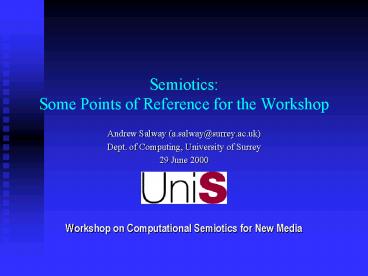Andrew Salway a'salwaysurrey'ac'uk - PowerPoint PPT Presentation
1 / 18
Title:
Andrew Salway a'salwaysurrey'ac'uk
Description:
Signification: systematic, structural aspects of signs; meaning-bearing potential ... or doctrines, from logic and metamathematics to linguistics, aesthetics, and all ... – PowerPoint PPT presentation
Number of Views:33
Avg rating:3.0/5.0
Title: Andrew Salway a'salwaysurrey'ac'uk
1
Semiotics Some Points of Reference for the
Workshop
- Andrew Salway (a.salway_at_surrey.ac.uk)
- Dept. of Computing, University of Surrey
- 29 June 2000
- Workshop on Computational Semiotics for New Media
2
Outline
- Semiotics, Semioticians Subject Matter
- Sign Typologies
- Semiosis
- Paradigms and Syntagms
- Aesthetic Frameworks
- Multimedia Communication
3
Semiotics
- Science of signs
- Signification systematic, structural aspects of
signs meaning-bearing potential - Communication transactional aspects of signs
cf. Jakobsons codes and messages, source and
destination, channel and context
4
Semioticians
- Saussure ? Hjelmslev ? Greimas, Metz and Eco
structuralism content-expression
(signified-signifier) linguistic bias paradigms
and syntagms - Peirce ? Morris rich typologies of signs
emphasis on process of semiosis (syntactic,
semantic, pragmatic dimensions) semiotic
typology of discourse - Eco toward a logic of culture a theory of
codes and a theory of sign production - Sebeok how the body interacts with the mind to
produce signs, messages, thought and ultimately
cultural behaviour
5
Subject Matter of Semiotics ENC
- it can deal with any object of knowledge
- (Eco anything that can be used to lie)
- NB. exchange of information through machines
conceived by humans, such as computers,
necessarily involves signs and semiotic processes
6
Areas of research belonging to semiotics E
- Zoosemiotics, olfactory signs, tactile
communication, coding of tastes, paralinguistics,
medical semiotics, kinesis and proxemics, musical
codes, formalized languages, written languages,
natural languages, visual communication??,
systems of objects, plot structure, text theory,
cultural codes, aesthetic texts, mass
communication, rhetoric
7
Headings in Handbook of Semiotics N
- Language and Language-Based Codes verbal
communication, sign language, paralanguage - Text semiotics literature, poetry, theatre and
drama, narrative, myth, ideology, theology - Nonverbal communication gesture, body language,
kinesics, facial signals, gaze, tactile
communication, proxemics, chronemics - Aesthetics and visual communication aesthetics,
music, architecture, objects, image, painting,
photography, film, comics, advertising
8
The Sign N
- Saussure signifier-signified arbitrary and
conventional signs (mentalistic) - Peirce
- Representatum (perceptible object) stands to
somebody, for something - Object in some respect
- To create an interpretant itself a sign
- Categories of Firstness, Secondness and Thirdness
9
Sign Typologies N
- 27 possible combinations
- Of the representatum qualisign, sinsign,
legisign, - Of relation to object icon, index, symbol,
- Of relation to interpretant rheme, dicent,
argument - Ten principal classes of sign, e.g.
- Rhematic Iconic Qualisign a feeling of red
- Rhematic Iconic Sinsign an individual
diagram - Dicent Indexical Sinsign a weathercock
- Rhematic Symbolic Legisign a common noun
- Argument Symbolic Legisign a syllogism
10
Semiosis
- Process in which the sign has a cognitive effect
on the interpreter N42 - Communication and signification two classes of
semiosis? N168 - Infinite Semiosis How can one represent this
type of semantic universe? E ? - Ross Quillians computational model of semantic
memory.
11
Paradigms and Syntagms C
- Semiotics as an approach to structural analysis
of texts - Saussurean semiotics signs are organised into
codes by - Paradigms (selection of signs)
- Syntagms (combination of signs)
12
Aesthetic Frameworks
- Fine Art (Panofsky) pre-iconographic
iconographic iconological - Film (Metz) physical diegetic cinematic
connotative sub-textual - Dance (Adshead-Lansdale) description
discernment of form interpretation evaluation
13
Multimedia Communication ENC
- a special type of communication characterised
by its media structure, though not explained by
merely adding the descriptive results of a
separate analysis of each medium - multichanneled and polysensual system of signs,
signals or codes - it is not, clearly, a single-levelled and
homogenous series of signs or signals that
emerges, but rather a weave of radically
differentiated modes of expression cf. Theatre
Semiotics (Elam) 29 sets of codes. - differences in semiotic status of different
strands - temporal and spatial fracture of the channels
- relationships between co-occurring media
- translatability between sign systems
14
Multimedia Communication ENC
- Transmission Channels light-waves sound-waves
biochemical thermodynamic electromagnetic - Senses acoustic olfactory gustatory
hapticaloptical - Modes icons symbols indices (symptoms
impulses) - Codes verbal paraverbal non-verbal
socio-perceptive psycho-physical - Signal Processing ?? Social/cultural systems
- Physical ?? Conceptual
- Perception ?? Cognition
15
Summary Five Notions of Semiotics ENC
- The syntactic, semantic and pragmatic properties
of the sign - A theory or discipline studying these properties
- Theories about how to study these properties
- Methods method of formalization method of
language analysis method of interpretation - Application use semiotics to analyze some
fragment of reality, e.g. arts, architecture,
film fashion, folk customs, etc.
16
Summary ENC
- Semiotics, depending on whether it is defined as
a type of research or as a doctrine, as a theory
or as a set of methods, can use the tools of
several sciences or doctrines, from logic and
metamathematics to linguistics, aesthetics, and
all the social sciences. - But, it must refer constantly and consistently
to any of its possible objects through sign and
sign functioning, using methods implying a theory
of signs and sign function
17
Direction of Semiotics?
- ?? Tendency towards discussions of aesthetics,
literary /cultural theory, psychoanalysis - ?? To the neglect of explicating information
processing / cognitive aspects
18
Short Bibliography
- E Eco, Umberto (1976). A Theory of Semiotics.
Indiana Uni Press. - ENC Sebeok, Thomas A. (ed. 1994). An
Encyclopedic Dictionary of Semiotics. Mouton de
Gruyter. - S Sebeok, Thomas A. (1994). Signs an
introduction to semiotics. Uni of Toronto Press - N Nöth, Winfried (ed. 1990). Handbook of
Semiotics. Indiana Uni Press. - For reference
- C Semiotics for Beginners, Daniel Chandler.
http//www.aber.ac.uk/media/Documents/S4B/ - Semiotics. University of Colorado at Denver
- http//www.cudenver.edu/mryder/itc_data/semiotic
s.html

